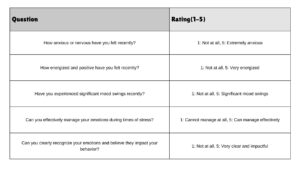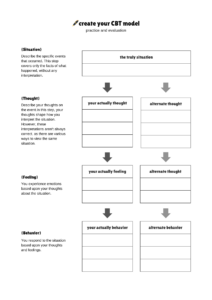Unlock Your Emotional Potential: Building Resilience and Awareness

Summary
This toolkit is designed to help learners improve their emotional awareness and resilience, provide practical emotion regulation techniques, and through reflection and self-assessment, help learners integrate emotion management skills into their daily lives and achieve continuous improvement in emotional health.
Introduction:
Welcome to the Unlock Your Emotional Potential toolkit! This toolkit is designed to help you build emotional resilience by increasing your emotional awareness and learning emotion regulation techniques. No matter your current emotional state or if you are experiencing stress and anxiety, this toolkit will help you better understand and manage your emotions.
(Reading and practicing time will be about 20 minutes)
🤔Questionnaire: Emotional Self-Assessment (2 minutes)
Please answer the following questions quickly within 2 minutes, choosing the number that best reflects your current feelings without overthinking.

😮💨Preparation: Deep Breathing Exercise (3 minutes)
Now that you have assessed your current emotional state, we will take a moment to do a brief deep breathing exercise to help you relax your body, sort out your emotions, and prepare for the next step.
Resource: https://youtu.be/Wemm-i6XHr8?si=eUTqGfwJf_hFjYRI (3min)
(This video resource provides a simple introduction and operation instructions for deep breathing method, which may be helpful to you!)
🤯Brainstorm: Identify and record emotions (3 minutes)
Recall the emotions in the past few days, write down two positive emotions and two negative emotions, and describe their manifestations. Please be as detailed as possible based on your first impression, including multiple aspects such as physical reactions and behavioral effects. ✍
Now that you have listed the emotions you experience, we will use CBT (Cognitive Behavioral Therapy) to reflect on how these emotions affect your thinking and behavior and explore whether there are more effective ways to deal with them.
🤓Evaluation: Reflecting on Emotions Using CBT flowchart (7 minutes)
Please review the emotions you recorded in the brainstorming session, select a recent negative emotion, and use the CBT flowchart to reflect on how you usually deal with this emotion and consider how to adjust your thinking and emotions in a more positive way.
The following is a simplified version of the CBT framework:

Create your own CBT flowchart and explore your own way of regulating emotions in the process.
🤔Reflection: Questionnaire again and reflection (5 minutes)
Please complete the Emotional Self-Assessment Questionnaire again (same questions). And reflect with reference to the following questions.
- Emotional changes: Looking back on your first and second self-assessments, have your emotions changed? Can you more clearly identify the causes of your emotional fluctuations?
- Challenges in emotional management: What difficulties have you encountered when using these tools? What aspects do you need to explore or adjust further?
- Skill effectiveness: When using deep breathing and CBT, which parts do you think are most helpful for your emotional stability and adjustment?
- New cognition: Has your understanding of your emotions changed during this process? Have you learned any new ways to cope with emotional reactions?
- Future coping: Do you think these newly learned skills and methods can help you better cope with future emotional fluctuations? How do you plan to apply them to actual situations?
Congratulations on completing this toolkit on emotional resilience and awareness building! You can try to apply these techniques to future emotional fluctuations.
I hope you can share your experience and reflections in the comment area (if you like) which may help you deepen your impression and possibly provide reference for other visitors! 🥰
Additional learning recourse
If you want to learn more about Cognitive Behavioral Therapy (CBT)to improve emotional resilience, I hope the following resources can help you! 🤓
CBT (Cognitive Behavioral Therapy) is a very effective psychotherapy method. Its core concept is that our thoughts, emotions and behaviors are interconnected. Changing thoughts can improve feelings, which in turn can change behavior.
This video explains the CBT cycle and how changing thoughts and behaviors is necessary in order to change feelings.
This website is a comprehensive platform that provides free CBT worksheets, articles and guides to understand and practice CBT.
Unlock Your Emotional Potential © 2024 by Yinuo Jia is licensed under CC BY-SA 4.0
questionnaire © 2024 by Yinuo Jia is licensed under CC BY-SA 4.0
NN CBT FLOWCHART © 2024 by Yinuo Jia is licensed under CC BY-SA 4.0


